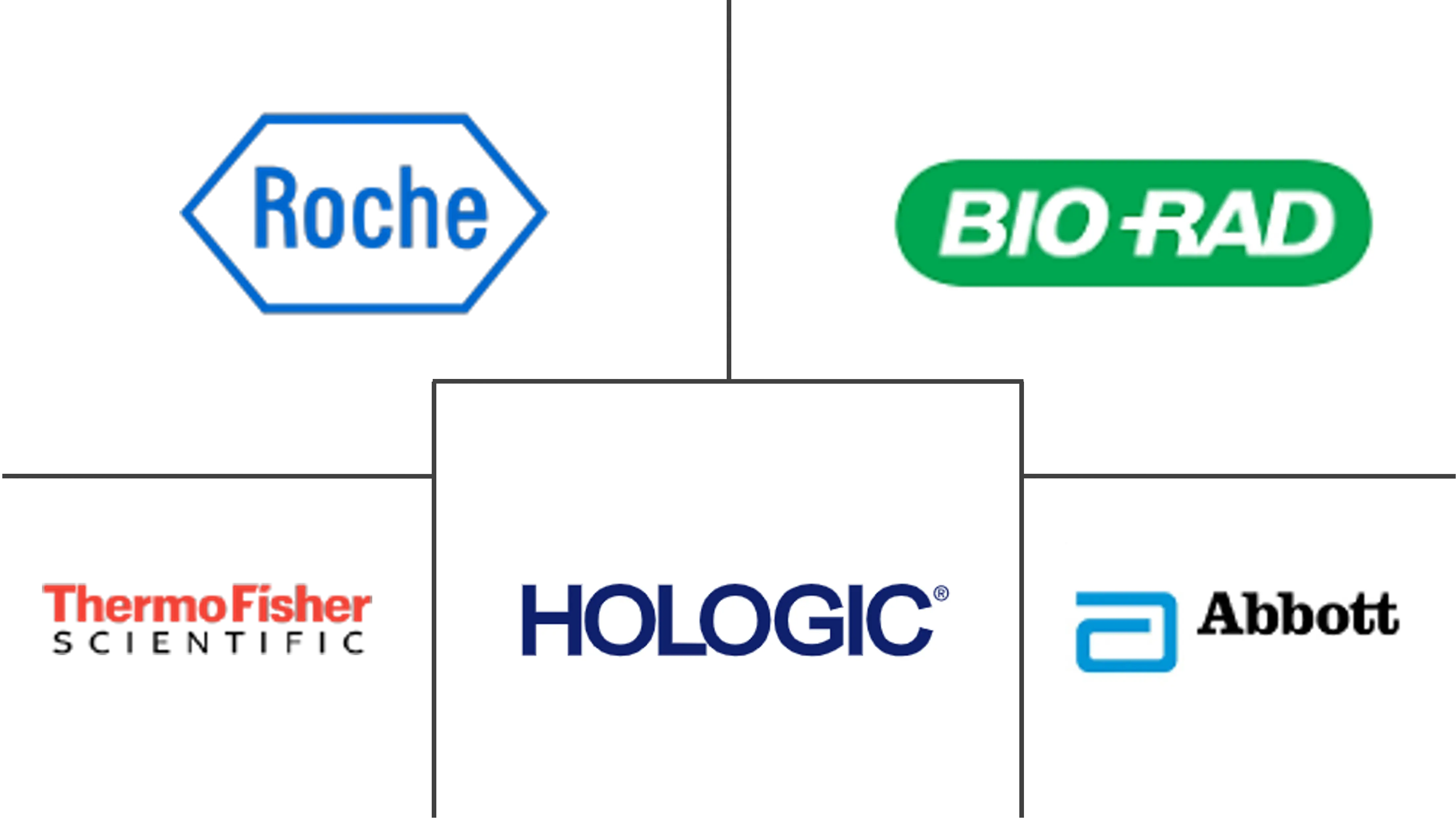Global Virology Testing Market Size and Share
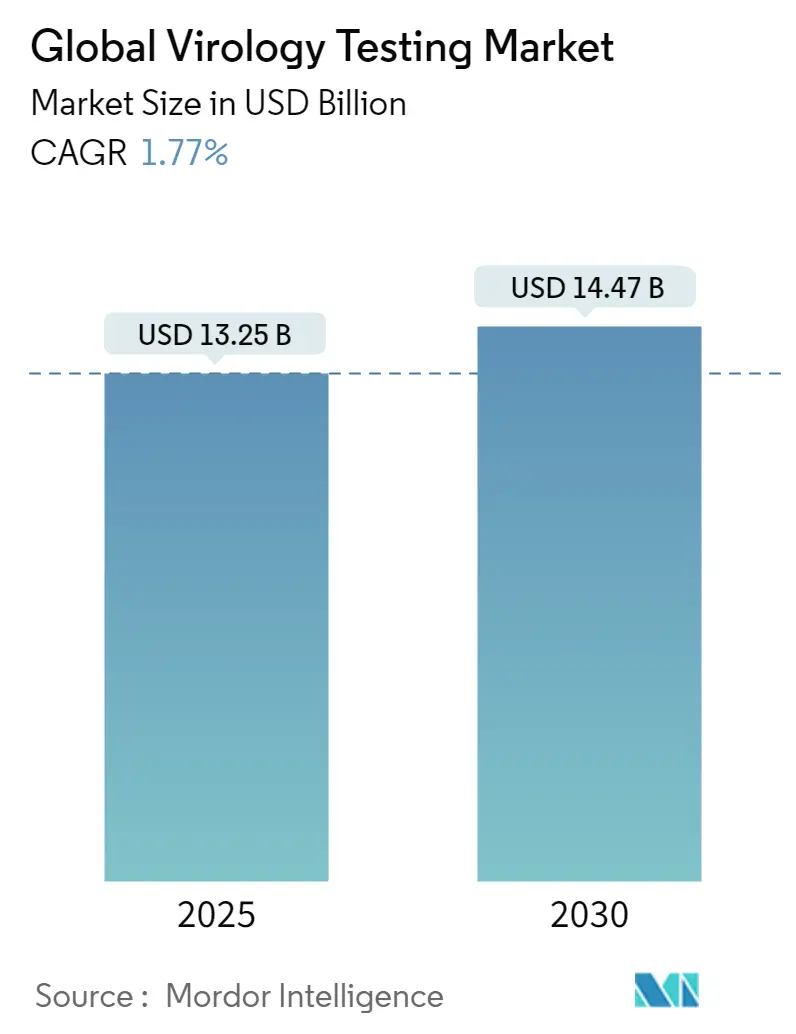
Global Virology Testing Market Analysis by Mordor Intelligence
The Global Virology Testing Market size is estimated at USD 13.25 billion in 2025, and is expected to reach USD 14.47 billion by 2030, at a CAGR of 1.77% during the forecast period (2025-2030).
The virology testing industry is experiencing significant transformation through technological advancement and automation, particularly in molecular diagnostics techniques. The integration of artificial intelligence (AI) in diagnostic platforms has revolutionized testing procedures, offering benefits such as increased accuracy, faster results, and improved patient outcomes. These technological innovations have enabled the development of more sophisticated testing methods, including next-generation sequencing and advanced PCR techniques, which provide more precise and reliable results while reducing the time required for diagnosis.
The market is witnessing a shift towards point-of-care testing solutions and home-based diagnostic options, reflecting changing healthcare delivery models and consumer preferences. This trend is exemplified by recent innovations such as Lucira Health's launch of their breakthrough COVID-19 & Flu Home Test in March 2023, marking one of the first combination tests approved for over-the-counter use at home. The increasing adoption of these convenient testing solutions is reshaping the traditional laboratory-based testing paradigm and expanding access to viral diagnostics services.
Laboratory testing services are evolving to meet the growing demand for comprehensive virus detection and monitoring capabilities. Major laboratories are expanding their test portfolios to include multiplex assays that can simultaneously detect multiple viral pathogens. This evolution is supported by the emergence of advanced diagnostic platforms that enable high-throughput testing while maintaining accuracy and reliability. The industry has seen significant developments in automated systems that can process large volumes of samples efficiently, reducing manual intervention and improving workflow optimization.
Strategic collaborations and partnerships between diagnostic companies, research institutions, and healthcare providers are becoming increasingly prevalent, driving innovation and market expansion. For instance, in March 2023, Virax Biolabs Group Limited entered into a distribution agreement for their Avian Influenza A Virus PCR test kit in the European Union, demonstrating the industry's focus on expanding access to advanced diagnostic solutions. Similarly, Mylab Discovery Solutions' launch of three new rapid kits for detecting sexually transmitted infections in February 2023 highlights the industry's commitment to addressing diverse diagnostic needs through technological innovation and strategic market expansion.
Global Virology Testing Market Trends and Insights
Surge in Prevalence of Viral Diseases Worldwide
The increasing number of viral infections among the population has created an urgent need for accurate and timely diagnosis, as well as monitoring of disease progression. According to the Joint United Nations Programme on HIV/AIDS (UNAIDS) data updated in 2023, approximately 1.3 million new cases of Human Immunodeficiency Virus (HIV) infections were diagnosed worldwide in 2022. The severity of viral outbreaks is further evidenced by the World Health Organization's report from April 2022, which documented 169 cases of acute hepatitis of unknown origin from 33 countries across five WHO Regions, with the United Kingdom accounting for 34% of these cases. Additionally, measles outbreaks have become increasingly concerning, with India reporting 67,592 cases and Yemen documenting 23,680 cases between December 2022 and May 2023, highlighting the persistent threat of viral diseases globally.
The emergence of new viral threats continues to underscore the critical importance of robust viral infection testing capabilities. For instance, according to the Centers for Disease Control and Prevention (CDC) data updated in July 2023, several European countries reported unprecedented monkeypox cases, with the United Kingdom recording 3,753 cases and Germany reporting 3,691 cases since the outbreak began in 2022. In Japan, viral hepatitis remains one of the most prevalent blood-borne infections, causing hepatitis, hepatic cirrhosis, and hepatocellular carcinoma, with approximately 3% of the population infected with hepatitis C virus infection, resulting in more than 30,000 liver-related complications annually. These statistics demonstrate the substantial burden of viral diseases worldwide, driving the demand for effective viral screening solutions and testing protocols.
Increasing Product Approvals
The virology testing market is experiencing significant growth driven by continuous product approvals and launches of innovative diagnostic solutions. In February 2023, Thermo Fisher Scientific announced that its Applied Biosystems TaqPath PCR kits for infectious diseases, including multi-drug-resistant tuberculosis, hepatitis B virus, hepatitis C virus, HIV, and genetic analysis, received licensing rights from the Central Drugs Standard Control Organization for manufacturing in India through a partnership with Mylab Discovery Solutions. Similarly, in May 2023, Mylab Discovery Solutions launched the PathoDetect HSV Type 1 & 2 Detection kit in India, a multiplex real-time PCR test that can detect and differentiate herpes simplex virus type I and type 2 in a single tube, demonstrating the industry's commitment to developing more efficient diagnostic tools.
The regulatory landscape continues to support innovation in viral testing technologies, as evidenced by several significant approvals in 2023. In January 2023, Virax Biolabs received CE marking for its human papillomavirus (HPV) test kits in Europe, covering 18 genotypes including type 53, which has shown higher risk and increasing spread. Additionally, in February 2023, the United States Food and Drug Administration granted emergency use authorization to the Lucira COVID-19 and Flu Home Test, marking it as the first over-the-counter at-home diagnostic test capable of differentiating and detecting influenza A and B alongside SARS-CoV-2, delivering results from self-collected nose swab samples in approximately 30 minutes. These developments reflect the industry's response to the growing demand for more sophisticated and accessible diagnostic solutions, including viral load testing and viral PCR testing.
Segment Analysis: By Type
Assay Kits and Consumables Segment in Virology Testing Market
The Assay Kits and Consumables segment dominates the global virology testing market, commanding approximately 66% market share in 2024. This segment's leadership position is primarily driven by the growing need for point-of-care diagnostics and the heavy usage of consumables as testing volumes increase worldwide. The segment has seen significant growth through continuous product innovations and launches by major market players. For instance, in 2023, Molbio Diagnostics launched Truenat HSV 1/2 for testing the Herpes Simplex Virus, while NeoDx Biotech Labs introduced seven real-time PCR-based kits for Hepatitis B, Hepatitis C, and HIV detection. The segment's growth is further supported by the increasing adoption of rapid diagnostic tests and the rising demand for home-based testing solutions. Additionally, the segment benefits from the expanding range of viral detection capabilities and improved accuracy of modern diagnostic kits.
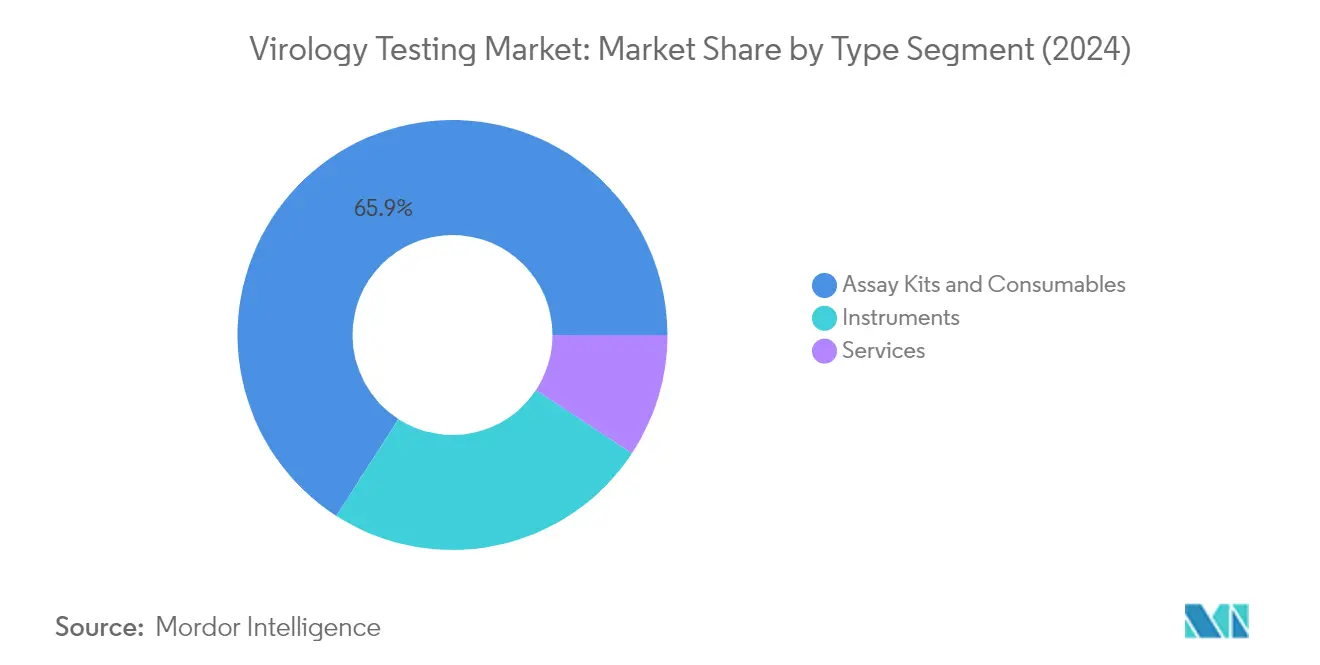
Remaining Segments in Virology Testing Market by Type
The Instruments and Services segments complete the virology testing market landscape, each playing crucial roles in the diagnostic ecosystem. The Instruments segment encompasses essential equipment such as polymerase chain reaction instruments, sequencing instruments, ELISA readers, immunoassay analyzers, and spectrophotometers, providing the technological foundation for viral testing and analysis. Recent technological advancements in these instruments have improved testing accuracy and reduced processing times. The Services segment offers specialized laboratory facilities and clinical diagnostic services, supporting healthcare providers with comprehensive testing solutions. This segment has evolved to include advanced testing methodologies and expanded service offerings, particularly in response to emerging viral threats and the growing demand for specialized diagnostic services.
Segment Analysis: By Diagnostic Technique
Molecular Diagnostics Segment in Virology Testing Market
The molecular diagnostics segment dominates the virology testing market, holding approximately 50% of the market share in 2024. This significant market position is driven by the segment's high sensitivity and specificity in detecting viral infections. The segment encompasses PCR-based methods and NGS-based methods, which are widely used for detecting and diagnosing viral infections such as SARS-CoV-2, HIV, hepatitis, and many others. Major market players are continuously launching innovative molecular diagnostics products, with companies like Thermo Fisher Scientific introducing viral surveillance panels capable of whole-genome sequencing and characterization of multiple viruses simultaneously. The segment's dominance is further strengthened by its ability to monitor viral infections' progression and track the spread of viral outbreaks in populations effectively.
Mass Spectroscopy Segment in Virology Testing Market
The mass spectroscopy-based method segment is projected to experience the fastest growth in the virology testing market during the forecast period 2024-2029, with an expected growth rate of approximately 3%. This growth is primarily attributed to recent technological advancements in MS technology, particularly in matrix-assisted laser desorption/ionization time-of-flight (MALDI-TOF) MS for detecting viral proteins in clinical samples. The segment's expansion is further supported by the development of high-resolution MS (HRMS) techniques for detecting and quantifying viral nucleic acids in clinical samples. Companies like Roche Diagnostics are planning to introduce fully automated mass spectrometry-based clinical analyzers, indicating strong future growth potential. The segment's rapid growth is also driven by its advantages in providing detailed molecular characterization of viruses and its ability to analyze a wide range of viral biomolecules simultaneously.
Remaining Segments in Diagnostic Technique
The immunoassay-based method and other diagnostic techniques continue to play vital roles in the virology testing market. Immunoassay-based methods are particularly valued for their cost-effectiveness and rapid results, making them suitable for large-scale screening and surveillance programs. These methods are widely used in detecting antibodies or antigens in patient samples and are particularly effective in diagnosing viral infections through ELISA, Western blot, and Immunofluorescence Assays. The 'Others' segment, which includes electron microscopy and microarray techniques, contributes to the market by providing specialized testing capabilities for specific viral detection needs. These remaining segments complement the molecular and mass spectroscopy methods by offering alternative approaches to viral detection and characterization, ensuring comprehensive diagnostic capabilities across different clinical settings.
Segment Analysis: By Application
Respiratory Tract Infections Segment in Virology Testing Market
The respiratory tract infections segment continues to dominate the global virology testing market, holding approximately 52% market share in 2024. This significant market position is primarily driven by the high prevalence of various respiratory viral infections worldwide and the growing demand for rapid and accurate diagnostic solutions. The segment's dominance is further strengthened by the extensive range of respiratory viruses being tested, including influenza A and B viruses, respiratory syncytial viruses, coronavirus, and parainfluenza virus adenovirus. The availability of advanced multiplex PCR panels that can simultaneously detect multiple respiratory pathogens has significantly enhanced the segment's market position. Additionally, the increasing focus on early detection and prevention of respiratory infections, coupled with the rising awareness about the importance of accurate diagnosis, has contributed to the segment's substantial market share. The role of respiratory virus testing in this segment is crucial for effective virus identification.
GI Tract Infections Segment in Virology Testing Market
The gastrointestinal (GI) tract infections segment is expected to demonstrate the highest growth rate of approximately 3% during the forecast period 2024-2029. This robust growth is attributed to the increasing incidence of viral gastroenteritis worldwide and the growing adoption of advanced diagnostic technologies for detecting various GI tract infections. The segment's growth is further fueled by the rising awareness about the importance of early detection of gastrointestinal viruses such as norovirus, rotavirus, adenovirus, and sapovirus. The development of innovative diagnostic techniques and the introduction of rapid testing solutions have significantly enhanced the detection capabilities for GI tract infections. Moreover, the increasing focus on preventing the spread of foodborne viral infections and the growing demand for point-of-care testing solutions in both developed and developing regions are contributing to the segment's accelerated growth rate.
Remaining Segments in Virology Testing Market by Application
The other segments in the virology testing market include skin and soft tissue infections, urinary tract infections, and eye infections, each serving specific diagnostic needs in their respective areas. The skin and soft tissue infections segment focuses on detecting viruses such as herpes simplex virus and varicella-zoster virus, while the urinary tract infection segment primarily addresses viral infections in immunocompromised individuals. The eye infections segment specializes in diagnosing viral conjunctivitis and other ocular viral infections. These segments are supported by continuous technological advancements in diagnostic methods and increasing healthcare awareness. The development of specialized testing solutions and the growing focus on personalized medicine have further enhanced the significance of these segments in the overall virology testing market, with viral serology and viral PCR testing playing pivotal roles.
Global Virology Testing Market Geography Segment Analysis
Virology Testing Market in North America
The North American virology testing market encompasses the United States, Canada, and Mexico, representing one of the most significant regions globally. The market's robust growth is driven by advanced healthcare infrastructure, high healthcare spending, and increasing prevalence of viral diseases. The region benefits from early adoption of innovative diagnostic technologies, a strong presence of major market players, and favorable reimbursement policies. Additionally, the extensive research and development activities in viral testing, coupled with strategic collaborations between academic institutions and industry players, contribute to the market's dynamism.
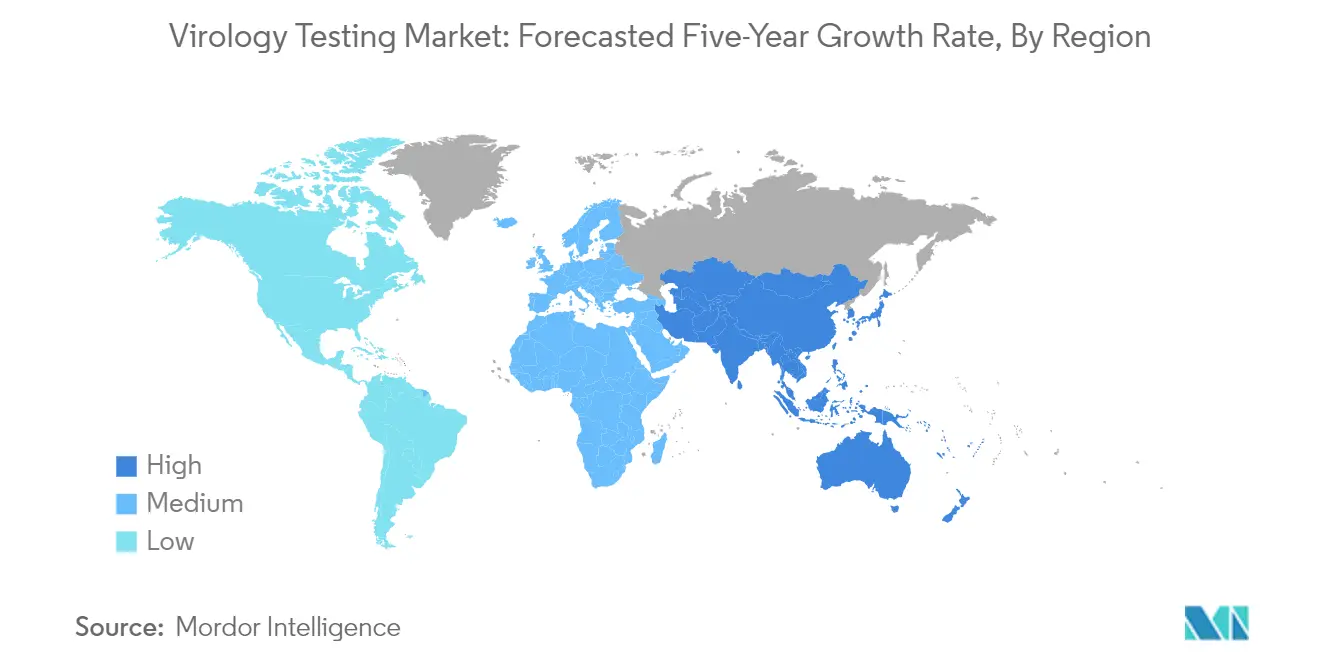
Virology Testing Market in the United States
The United States dominates the North American virology testing market, holding approximately 84% market share in the region. The country's market leadership is attributed to its sophisticated healthcare system, substantial investment in diagnostic infrastructure, and the presence of leading diagnostic companies. The implementation of comprehensive screening programs, rising awareness about early viral detection, and increasing healthcare expenditure further strengthen the market. The country's robust regulatory framework, coupled with continuous technological advancements in molecular diagnostics and immunoassays, creates a conducive environment for market growth. The United States also leads in research initiatives and clinical trials related to viral testing, supported by significant government funding and private sector investments.
Virology Testing Market in Mexico
Mexico emerges as the fastest-growing market in North America, with a projected CAGR of approximately 2% during 2024-2029. The country's growth is driven by improving healthcare infrastructure, increasing healthcare accessibility, and rising awareness about viral diseases. Mexico's expanding diagnostic capabilities, coupled with government initiatives to enhance healthcare services, contribute to market expansion. The country is witnessing increased adoption of advanced diagnostic technologies and growing investments in healthcare facilities. Furthermore, the rising prevalence of viral infections and the government's focus on strengthening diagnostic capabilities create significant growth opportunities in the Mexican virology testing market.
Virology Testing Market in Europe
The European virology testing market demonstrates strong growth potential, encompassing key countries including Germany, the United Kingdom, France, Italy, and Spain. The region's market is characterized by sophisticated healthcare systems, strong research capabilities, and high adoption rates of advanced diagnostic technologies. European countries benefit from well-established healthcare infrastructure, comprehensive reimbursement policies, and significant investments in diagnostic research. The presence of leading diagnostic companies and research institutions further strengthens the market landscape.
Virology Testing Market in Germany
Germany leads the European virology testing market, commanding approximately 23% market share in the region. The country's market dominance is supported by its advanced healthcare system, robust research infrastructure, and high healthcare spending. Germany's strong focus on technological innovation, coupled with the presence of major diagnostic companies, drives market growth. The country's comprehensive healthcare coverage and emphasis on preventive care contribute to the high adoption of infectious disease testing. Additionally, Germany's leadership in research and development activities and strong clinical trial infrastructure further solidify its position.
Virology Testing Market in France
France demonstrates the highest growth potential in the European region, with a projected CAGR of approximately 3% during 2024-2029. The country's market growth is driven by increasing investment in healthcare infrastructure, rising adoption of advanced diagnostic technologies, and growing awareness about viral diseases. France's strong focus on healthcare innovation and research excellence contributes to market expansion. The country's comprehensive healthcare system and government initiatives to improve diagnostic capabilities further support market growth. Additionally, France's active participation in clinical research and development of innovative diagnostic solutions enhances its market position in clinical virology.
Virology Testing Market in Asia-Pacific
The Asia-Pacific virology testing market encompasses diverse economies including China, Japan, India, Australia, and South Korea. The region demonstrates significant growth potential driven by improving healthcare infrastructure, increasing healthcare expenditure, and rising awareness about viral diseases. The market benefits from large patient populations, growing adoption of advanced diagnostic technologies, and increasing investment in healthcare facilities. Government initiatives to enhance healthcare accessibility and a growing focus on preventive healthcare further contribute to market expansion.
Virology Testing Market in China
China emerges as the largest market in the Asia-Pacific region, driven by its extensive healthcare system reforms and significant investments in diagnostic infrastructure. The country's market leadership is supported by its large population base, increasing healthcare expenditure, and growing adoption of advanced diagnostic technologies. China's focus on improving healthcare accessibility and quality, coupled with rising awareness about viral diseases, contributes to market growth. The country's strong manufacturing capabilities and growing research activities in viral testing further strengthen its market position.
Virology Testing Market in India
India demonstrates remarkable growth potential in the Asia-Pacific region, driven by its improving healthcare infrastructure and increasing focus on diagnostic services. The country's market expansion is supported by rising healthcare awareness, growing investment in healthcare facilities, and increasing adoption of advanced diagnostic technologies. India's large patient population and growing emphasis on preventive healthcare contribute to market growth. The country's emerging research capabilities and increasing focus on developing affordable diagnostic solutions further enhance its market position in clinical virology.
Virology Testing Market in the Middle East and Africa
The Middle East and Africa virology testing market, comprising regions like the GCC and South Africa, demonstrates growing potential in the global landscape. The market is characterized by improving healthcare infrastructure, increasing healthcare awareness, and rising government initiatives to enhance diagnostic capabilities. The region benefits from growing investment in healthcare facilities and increasing adoption of advanced diagnostic technologies. Among the countries, the GCC emerges as the largest market while also showing the fastest growth, supported by substantial healthcare investments and modernization of healthcare facilities. The region's focus on developing healthcare infrastructure and increasing healthcare accessibility contributes to market expansion.
Virology Testing Market in South America
The South American virology testing market, including countries like Brazil and Argentina, shows promising growth potential. The region's market is driven by improving healthcare infrastructure, increasing healthcare awareness, and growing government initiatives to enhance diagnostic capabilities. The market benefits from large patient populations and rising adoption of advanced diagnostic technologies. Brazil emerges as both the largest and fastest-growing market in the region, supported by its extensive healthcare system and significant investments in diagnostic infrastructure. The region's focus on improving healthcare accessibility and quality contributes to market expansion.
Competitive Landscape
Top Companies in Virology Testing Market
The virology testing market features prominent players like F. Hoffmann-La Roche, Bio-Rad Laboratories, Abbott Laboratories, Thermo Fisher Scientific, and BioMerieux SA leading the competitive landscape. These companies are heavily investing in research and development to introduce innovative molecular diagnostics platforms and expand their test menu offerings. Strategic partnerships and collaborations with research institutions and healthcare providers have become increasingly common to enhance market presence and technological capabilities. Companies are focusing on geographical expansion through distribution agreements and local manufacturing facilities, particularly in emerging markets. The industry has seen significant product launches in areas like multiplex PCR testing, rapid diagnostics, and automated testing platforms. Operational agility has become crucial as companies work to maintain supply chain resilience and manufacturing flexibility to meet fluctuating demand patterns.
Consolidated Market Led By Global Players
The virology testing industry demonstrates a relatively consolidated structure dominated by large multinational healthcare conglomerates with diverse product portfolios spanning diagnostics, life sciences, and medical devices. These established players leverage their extensive research capabilities, global distribution networks, and strong financial positions to maintain market leadership. Regional and specialized players maintain a significant presence in specific geographic markets or testing segments, often competing through focused expertise and local market understanding. The market has witnessed active merger and acquisition activity, with larger companies acquiring innovative startups and regional players to expand their technological capabilities and geographic reach.
The competitive dynamics are characterized by high entry barriers due to stringent regulatory requirements, substantial capital investments needed for research and development, and the importance of established relationships with healthcare providers and laboratories. Market leaders have built comprehensive product ecosystems including instruments, reagents, and software solutions, creating customer loyalty through integrated testing platforms. The industry structure encourages long-term partnerships between manufacturers and healthcare facilities, as switching costs remain high due to equipment compatibility requirements and staff training investments.
Innovation and Integration Drive Market Success
For established players to maintain and expand their market share, focus needs to be placed on continuous innovation in testing technologies, particularly in areas of automation, multiplexing capabilities, and result turnaround time. Companies must invest in developing user-friendly platforms that integrate seamlessly with laboratory information systems while reducing operational costs for end-users. Building comprehensive service and support networks, offering flexible financing options, and maintaining strong relationships with key opinion leaders and healthcare institutions are crucial strategies. Additionally, incumbent players need to actively pursue opportunities in emerging markets while adapting their solutions to meet local healthcare needs and regulatory requirements.
New entrants and challenger companies can gain ground by focusing on specialized market segments or innovative technologies that address specific unmet needs in virology testing. Success factors include developing cost-effective solutions that improve laboratory efficiency, reducing manual intervention, and providing superior data management capabilities. Companies must navigate complex regulatory environments while building evidence to demonstrate the clinical utility and cost-effectiveness of their solutions. The ability to form strategic partnerships with established players for distribution or technology integration, while maintaining agility in product development and market response, will be critical for sustainable growth. Future success will increasingly depend on addressing emerging challenges in healthcare delivery, such as decentralized testing needs and integration with digital health platforms.
Global Virology Testing Industry Leaders
-
F. Hoffmann-La Roche AG
-
Bio-Rad Laboratories Inc
-
Hologic Inc.
-
Thermo Fisher Scientific Inc.
-
Abbott Laboratories
- *Disclaimer: Major Players sorted in no particular order
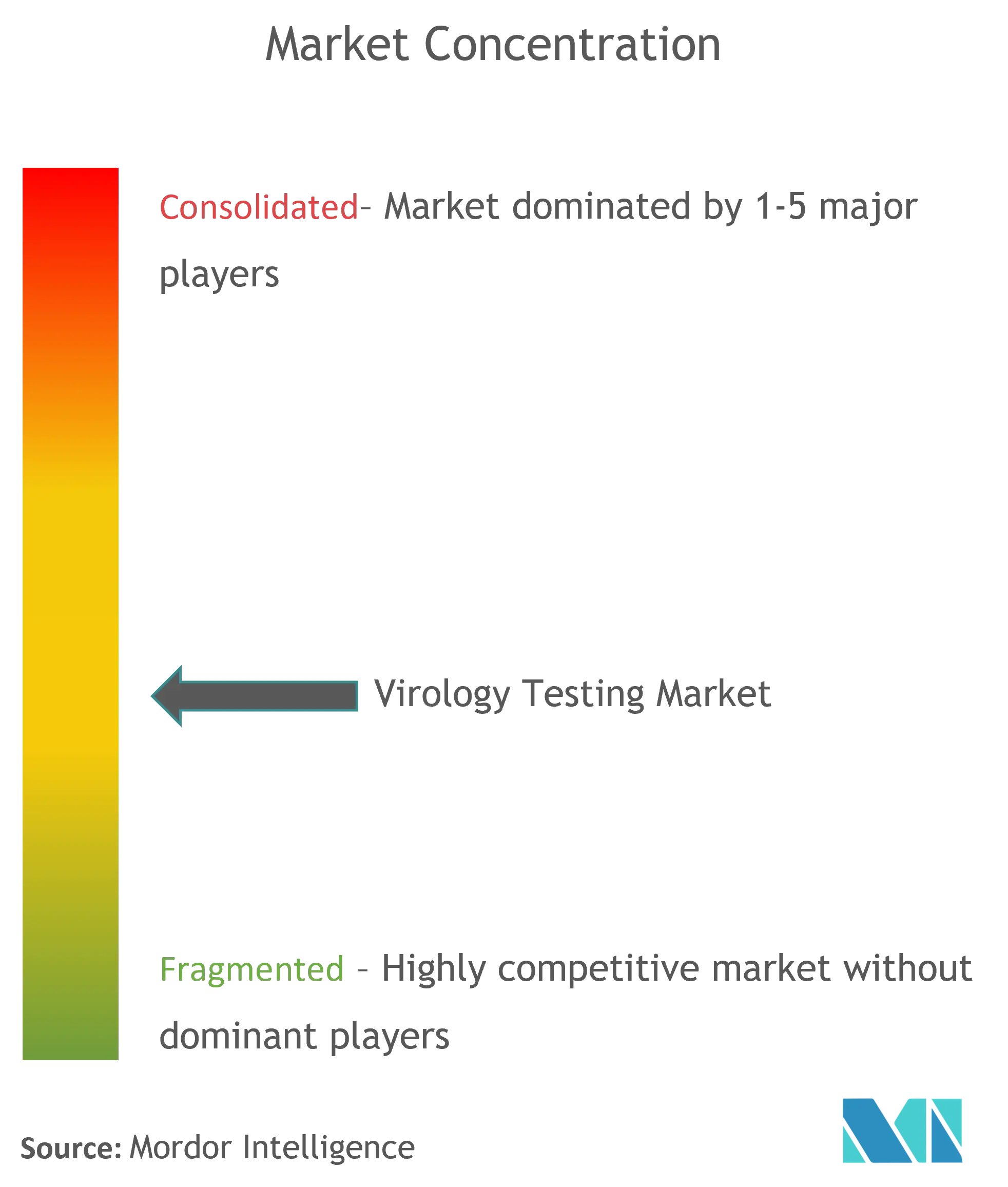
Recent Industry Developments
In May 2022, QuantuMDx Group Limited announced the launch of its new respiratory panel test; Q-POC SARS-CoV-2, Flu A/B & RSV Assay. The Q-POC platform and its multiplex capabilities provide customers with rapid, point-of-care testing in both clinical and non-clinical settings.
In January 2022, InTec announced the launch of a novel ultra-sensitive SARS-CoV-2 Rapid Antigen Test -AQ+ Covid-19 Ag Rapid Test for professional use. The AQ+ Covid-19 Ag Rapid Test is intended for use by healthcare professionals or laypersons to rapidly and conveniently detect Covid-19.
Global Virology Testing Market Report Scope
As per the scope of the report, virology testing involves different diagnostic techniques used in identifying viruses. Viruses can be diagnosed by different procedures such as cell culture methods, specific antibody detection, antigen detection, virus nucleic acid detection, gene sequencing, and hemagglutination assays. The Virology Testing Market is segmented By Type (Instruments, Assay Kits and Consumables), By Diagnostic Technique (Molecular Diagnostics Method, Immunoassay based Method, Mass Spectroscopy based Method, and Others), By End User (Hospitals and Clinics, Diagnostic Laboratories, and Others) and Geography (North America, Europe, Asia-Pacific, Middle East & Africa, and South America). The report offers value (in USD million) for the above segments. The market report also covers the estimated market sizes and trends for 17 different countries across major regions, globally.
| Instruments |
| Assay Kits and Consumables |
| Molecular Diagnostics Method | PCR-based methods |
| NGS-based methods | |
| Immunoassay-based Method | |
| Mass Spectroscopy-based Method | |
| Others |
| Hospitals and Clinics |
| Diagnostic Laboratories |
| Others |
| North America | United States |
| Canada | |
| Mexico | |
| Europe | Germany |
| United Kingdom | |
| France | |
| Italy | |
| Spain | |
| Rest of Europe | |
| Asia-Pacific | China |
| Japan | |
| India | |
| Australia | |
| South Korea | |
| Rest of Asia-Pacific | |
| Middle-East and Africa | GCC |
| South Africa | |
| Rest of Middle-East and Africa | |
| South America | Brazil |
| Argentina | |
| Rest of South America |
| By Type | Instruments | |
| Assay Kits and Consumables | ||
| By Diagnostic Technique | Molecular Diagnostics Method | PCR-based methods |
| NGS-based methods | ||
| Immunoassay-based Method | ||
| Mass Spectroscopy-based Method | ||
| Others | ||
| By End User | Hospitals and Clinics | |
| Diagnostic Laboratories | ||
| Others | ||
| Geography | North America | United States |
| Canada | ||
| Mexico | ||
| Europe | Germany | |
| United Kingdom | ||
| France | ||
| Italy | ||
| Spain | ||
| Rest of Europe | ||
| Asia-Pacific | China | |
| Japan | ||
| India | ||
| Australia | ||
| South Korea | ||
| Rest of Asia-Pacific | ||
| Middle-East and Africa | GCC | |
| South Africa | ||
| Rest of Middle-East and Africa | ||
| South America | Brazil | |
| Argentina | ||
| Rest of South America | ||
Key Questions Answered in the Report
How big is the Global Virology Testing Market?
The Global Virology Testing Market size is expected to reach USD 13.25 billion in 2025 and grow at a CAGR of 1.77% to reach USD 14.47 billion by 2030.
What is the current Global Virology Testing Market size?
In 2025, the Global Virology Testing Market size is expected to reach USD 13.25 billion.
Who are the key players in Global Virology Testing Market?
F. Hoffmann-La Roche AG, Bio-Rad Laboratories Inc, Hologic Inc., Thermo Fisher Scientific Inc. and Abbott Laboratories are the major companies operating in the Global Virology Testing Market.
Which is the fastest growing region in Global Virology Testing Market?
Asia-Pacific is estimated to grow at the highest CAGR over the forecast period (2025-2030).
Which region has the biggest share in Global Virology Testing Market?
In 2025, the North America accounts for the largest market share in Global Virology Testing Market.
What years does this Global Virology Testing Market cover, and what was the market size in 2024?
In 2024, the Global Virology Testing Market size was estimated at USD 13.02 billion. The report covers the Global Virology Testing Market historical market size for years: 2019, 2020, 2021, 2022, 2023 and 2024. The report also forecasts the Global Virology Testing Market size for years: 2025, 2026, 2027, 2028, 2029 and 2030.
Page last updated on:
